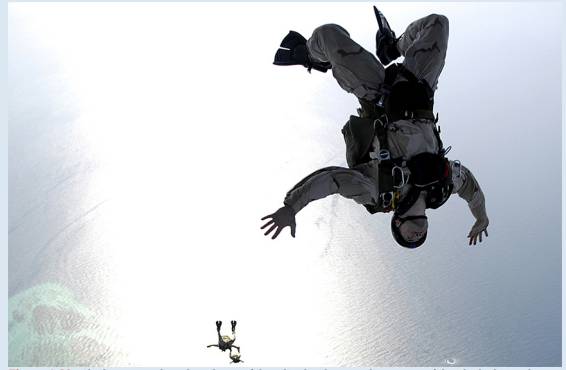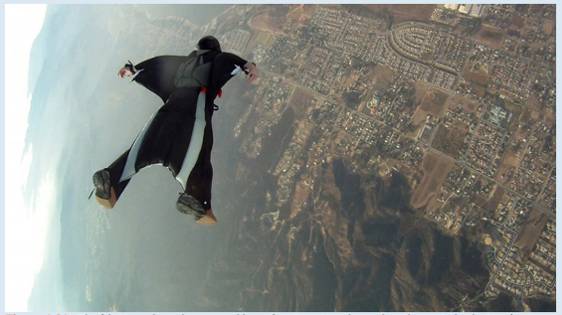
A Parachutist in Free Fall

Figure 1.30 Skydivers can adjust [he velocity of their dive by changing the position of their body during the free fall. (credit: Jeremy T. Lock)
Julie is an avid skydiver. She has more than 30 jumps under her belt and has mastered the art of making adjustments
to her body position in the air to control how fast she falls. If she arches her back and points her belly toward the
ground, she reaches a terminal velocity of approximately 120 mph [176 ft/sec). If, instead, she orients her body with
her head straight down, she falls faster, leaching a terminal velocity of 150 mph (220 ft/sec).
Since Julie will be moving (falling) in a downward direction, we assume the downward direction is positive to simplify
our calculations. Julie executes her jumps from an altitude of 12,500 ft. After she exits the aircraft, she immediately
starts falling at a velocity given by v(t) = 32t. She continues to accelerate according to this velocity function until she
reaches terminal velocity. After she reaches terminal velocity, her speed remains constant until she pulls her ripcord
and slaws down In land.
On her first jump of the day, Julie orients herself in the slower "belly down” position (terminal velocity is 176 ft/sec).
Using this information, answer the following questions.
6. Before pulling her ripcord. Julie reorients her body in the “belly down” position so she is not moving quite as fast when her parachute opens. If she begins this maneuver at an altitude of 4000 ft. how long does she spend in a free fall before beginning the reorientation?
Some jumpers wear “wingsuits” (see Figure 1.31). These suits have fabric panels between the arms and legs and allow the wearer to glide around in a free fall, much like a flying squirrel. (Indeed, the suits are sometimes called flying squirrel suits.”) When wearing these suits, terminal velocity can be reduced to about 30 mph (44 ft/sec ), allowing the wearers a much longer tin in the air. Wingsuit flyers still use parachutes to land: although the vertical velocities are within the margin of safety, horizontal velocities can exceed 70 mph, much too fast to land safely.

Figure 1.31 The fabric panels on the arms and legs of a wingsuit work to reduce me vertical velocity of a skydiver’s fall. (credit: Richard Schneider)
Want to see the full answer?
Check out a sample textbook solution
Chapter 1 Solutions
Calculus Volume 2
Additional Math Textbook Solutions
Using and Understanding Mathematics: A Quantitative Reasoning Approach (6th Edition)
Thinking Mathematically (6th Edition)
Calculus: Early Transcendentals (2nd Edition)
A First Course in Probability (10th Edition)
Elementary Statistics: Picturing the World (7th Edition)
Elementary Statistics (13th Edition)
- 7. Show that for R sufficiently large, the polynomial P(z) in Example 3, Sec. 5, satisfies the inequality |P(z)| R. Suggestion: Observe that there is a positive number R such that the modulus of each quotient in inequality (9), Sec. 5, is less than |an|/n when |z| > R.arrow_forward9. Establish the identity 1- 1+z+z² + 2n+1 ... +z" = 1- z (z1) and then use it to derive Lagrange's trigonometric identity: 1 1+ cos cos 20 +... + cos no = + 2 sin[(2n+1)0/2] 2 sin(0/2) (0 < 0 < 2л). Suggestion: As for the first identity, write S = 1+z+z² +...+z" and consider the difference S - zS. To derive the second identity, write z = eie in the first one.arrow_forward8. Prove that two nonzero complex numbers z₁ and Z2 have the same moduli if and only if there are complex numbers c₁ and c₂ such that Z₁ = c₁C2 and Z2 = c1c2. Suggestion: Note that (i≤ exp (101+0) exp (01-02) and [see Exercise 2(b)] 2 02 Ꮎ - = = exp(i01) exp(101+0) exp (i 01 - 02 ) = exp(102). i 2 2arrow_forward
- numerical anaarrow_forward13. If X has the distribution function F(x) = 0 1 12 for x < -1 for -1x < 1 for 1x <3 2 3 for 3≤x≤5 4 1 for x≥5 find (a) P(X ≤3); (b) P(X = 3); (c) P(X < 3); (d) P(X≥1); (e) P(-0.4arrow_forwardTwo measurements are made of some quantity. For the first measurement, the average is 74.4528, the RMS error is 6.7441, and the uncertainty of the mean is 0.9264. For the second one, the average is 76.8415, the standard deviation is 8.3348, and the uncertainty of the mean is 1.1448. The expected value is exactly 75. 13. Express the first measurement in public notation. 14. Is there a significant difference between the two measurements? 1 15. How does the first measurement compare with the expected value? 16. How does the second measurement compare with the expected value?arrow_forwardNo chatgpt pls will upvote Already got wrong chatgpt answer .arrow_forwardIf you use any chatgpt will downvote.arrow_forwardPlease help I'm a working mom trying to help my son last minute (6th grader)! Need help with the blank ones and check the ones he got with full calculation so we can use it to study! Especially the mixed number fractions cause I'm rusty. Thanks in advance!arrow_forward|| 38 5층-11- 6 4 7 2 6arrow_forward4. Consider the initial value problem y' = 3x(y-1) 1/3, y(xo) = yo. (a) For what points (co, yo) does the IVP have a solution? (b) For what points (xo, yo) does the IVP have a unique solution on some open interval that contains 20? (c) Solve the IVP y' = 3x(y-1) 1/3, y(0) = 9 and determine the largest open interval on which this solution is unique.arrow_forwardFind the limit. (If the limit is infinite, enter 'oo' or '-o', as appropriate. If the limit does not otherwise exist, enter DNE.) lim X→ ∞ (✓ 81x2 - 81x + x 9x)arrow_forwardarrow_back_iosSEE MORE QUESTIONSarrow_forward_ios
 Elementary AlgebraAlgebraISBN:9780998625713Author:Lynn Marecek, MaryAnne Anthony-SmithPublisher:OpenStax - Rice University
Elementary AlgebraAlgebraISBN:9780998625713Author:Lynn Marecek, MaryAnne Anthony-SmithPublisher:OpenStax - Rice University Glencoe Algebra 1, Student Edition, 9780079039897...AlgebraISBN:9780079039897Author:CarterPublisher:McGraw Hill
Glencoe Algebra 1, Student Edition, 9780079039897...AlgebraISBN:9780079039897Author:CarterPublisher:McGraw Hill
 Trigonometry (MindTap Course List)TrigonometryISBN:9781337278461Author:Ron LarsonPublisher:Cengage Learning
Trigonometry (MindTap Course List)TrigonometryISBN:9781337278461Author:Ron LarsonPublisher:Cengage Learning Algebra: Structure And Method, Book 1AlgebraISBN:9780395977224Author:Richard G. Brown, Mary P. Dolciani, Robert H. Sorgenfrey, William L. ColePublisher:McDougal LittellAlgebra & Trigonometry with Analytic GeometryAlgebraISBN:9781133382119Author:SwokowskiPublisher:Cengage
Algebra: Structure And Method, Book 1AlgebraISBN:9780395977224Author:Richard G. Brown, Mary P. Dolciani, Robert H. Sorgenfrey, William L. ColePublisher:McDougal LittellAlgebra & Trigonometry with Analytic GeometryAlgebraISBN:9781133382119Author:SwokowskiPublisher:Cengage





